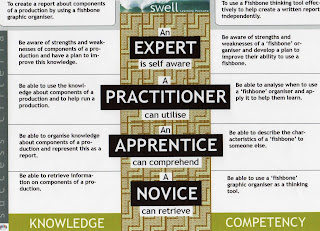Year Level: 2,3,4
Teacher: Philippa Rogers
Focus area: Managing Self: To investigate ways to improve student capability to manage self including student awareness of and ability to use key learning tools for their achievement level e.g. organisational and thinking tools
Research Questions:
Question 1. Implementation: How can students be supported to develop their ability to use a ‘fishbone’ graphic organiser through repetitive use in the class writing programme?
Question 2. Engagement: What impact does using the ‘fishbone’ graphic organiser have on student engagement?
Question 3. Knowledge: What impact does using the ‘fishbone’ graphic organiser have on the student knowledge of the various components of a school production?
Success Criteria for Knowledge
Expert: Be aware of strengths and weaknesses of components of a production and have a plan to improve this knowledge.
Practitioner: Be able to use the knowledge about components of a production and to help run a production.
Apprentice: Be able to organise knowledge about components of a production and represent this as a report.
Novice: Be able to retrieve information on components of a production.
Question 4. Competency: What impact does using ‘fishbone’ graphic organisers repetitively in the language programme have on student competency to use the tool in other knowledge areas?
Success Criteria for Competency
Expert: Be aware of strengths and weaknesses of a ‘fishbone’ organiser and develop a plan to improve their ability to use a fishbone.
Practitioner: Be able to analyse when to use a ‘fishbone’ organiser and apply it to help them learn.
Apprentice: Be able to describe the characteristics of a ‘fishbone’ to someone else.
Novice: Be able to use a ‘fishbone’ graphic organiser as a thinking tool.
Learning Story:
The students began with using an ‘information web’ organiser to brainstorm ideas on what they know about what is involved in putting on a production.
The second task was to present to the class a blank ‘fishbone’ graphic organiser (the students had not used one of these before) and without prior teaching, allow the students to organize their ideas around a recent school event. At the outset not many students knew how to use this type of thinking tool and most could not complete it successfully in the time allocated.
(19 children out of 22 were recorded as Novices from the intial task)
The ‘Learning Poutama’ rubric was explained and displayed on the whiteboard.( I used a blank Poutama and copied and pasted in my Knowledge and Competency success criteria from my 'Action Research Planning template' - I think it is important that our children too can learn and speak the language we are using as teachers).
Next learning steps were discussed and how they could achieve or progress to each stage.
During the writing programme, ‘fishbone’ organisers were used on various topics of work, e.g. visits from outside speakers, personal views, current events, etc. This process helped to increase the students understanding of how to use this thinking tool.
During this action research, our school production was in full swing and lots of discussion centered around the many components of managing a show. Each notice that went home asking for help with either costumes, sound, props, lighting, makeup,etc were talked about and analysed. The children worked in co-operative groups to brainstorm ideas on what needs to be organised for the different components of a school production.
At the end of the research, students created a report on their knowledge about components of a production. They were required to use a fishbone thinking tool to help them write this report independently.
I interviewed the students as they were completing their ‘fishbone’ about the strengths and weaknesses of using this tool ('expert' level).
From their report, I could assess what stage they had reached (not expecting 'practitioner' level as the school production was not their own).
However, soon after the class got the opportunity to write how they would run a class play and what components they would need to consider – this was a great way to assess whether they were a practitioner or an expert.
Students also completed an ‘engagement’ questionnaire after we had finished our topic.
Results:
Outcome 1. Engagement:
SCALE: 1 = never, 2 = not very often, 3 = about half the time, 4 = often, 5 = always
Mean level of engagement of students ...
Offered ideas - 3.3
Asked questions - 2.7
Listened to and thought about other's ideas and responded respectfully - 3.9
Used positive body language related to task - 3.8
Persevered in order to enact related task - 4.0
Showed evidence of being active learners outside school time - 2.7
Showed interest in directing their own learning - 3.4
Had behavioural issues that impacted on their learning - 1.7
Showed evidence of using what they have learnt - 3.5
Overall mean level of engagement of students = 3.4
Outcome 2. Knowledge:
Number of students who were ...
8. Proficient experts - at start [0]; at end [0]
7. Beginning experts - at start [0]; at end [0]
6. Proficient practitioners - at start [0]; at end [0]
5. Beginning practitioners - at start [0]; at end [9]
4. Proficient apprentices - at start [0]; at end [7]
3. Beginning apprentices - at start [0]; at end [5]
2. Proficient novices - at start [8]; at end [2]
1. Beginning novices - at start [15]; at end [0]
Knowledge effect size = 1.33
Standard error =0.09
Outcome 3. Competency:
Number of students who were ...
8. Proficient experts - at start [0]; at end [0]
7. Beginning experts - at start [0]; at end [4]
6. Proficient practitioners - at start [0]; at end [5]
5. Beginning practitioners - at start [0]; at end [6]
4. Proficient apprentices - at start [0]; at end [3]
3. Beginning apprentices - at start [3]; at end [2]
2. Proficient novices - at start [11]; at end [2]
1. Beginning novices - at start [8]; at end [0]
Competency effect size = 1.54
Standard error =0.16
Conclusions:
Question 1. Implementation: How can students be supported to develop their ability to use a ‘fishbone’ graphic organiser through repetitive use in the class writing programme?
Once the students had used a 'fishbone' organiser initially, we discussed as a class how it could be effectively used to record their ideas. We looked at different samples of the children's work and made class 'fishbones' during our language programme.We discussed the advantages and disadvantages of using this graphic organsier. The process helped immensely with the understanding of this great thinking tool.
Question 2. Engagement: What impact does using the ‘fishbone’ graphic organiser have on student engagement?
It certainly focuses the students on their work and their ideas were a lot more specific than in previous brainstorming activities. As the 'fishbone' organiser was used more frequently, the students settled quickly to the task assigned to them - the children were very engaged and interested in their learning.
Question 3. Knowledge: What impact does using the ‘fishbone’ graphic organiser have on the student knowledge of the various components of a school production?
This was a great topic to link into 'fishbone' graphic organisers as it was able to be broken into the different components quite easily. After unpacking the various aspects of a production in co-operative groups, most students could readily transfer this information onto a 'fishbone' organsier.
Question 4. Competency: What impact does using ‘fishbone’ graphic organisers repetitively in the language programme have on student competency to use the tool in other knowledge areas?
After using this thinking tool in their writing programme, I gave them other opportunities to use the 'fishbone' organiser, i.e. in the Health programme, Religious Education activities and in homework tasks ( here they also had to explain to their parents the characteristics of a 'fishbone', reinforcing the 'apprentice' stage).Co-operative group activities,using an enlarged 'fishbone' template,worked well and was very successful.
Final comment
The competency data shows that at the beginning of the unit 86% of students were at the novice level. They had limited ability or knowledge on how to use a ‘fishbone’ thinking tool effectively. By the end of the Term 68% of the class had become practitioners or experts.
The students’ knowledge about components of a production was also limited at the start (all at the Novice level), but this increased as our school production and lots of discussion took place during the unit. As the show was basically run by teachers it did not allow the opportunity for the children to become experts, but nearly 40% of students achieved at the practitioner level.
The children were highly engaged and enthusiastic throughout this unit and were very motivated to run a production of their own – unfortunately time did not allow this to happen, but would have been great to carry the activity through on another occasion.






















1 comment:
Well done Philippa. Great to see your work online. It is also good to see that repetitive use of a thinking tool such as the Fishbone in the language programme does transfer to students using it in other knowledge areas.
I like the idea you developed for recording success criteria on the Learning Poutama in students' language. I might see if we can get a set of Learning Poutama made up and laminated A3 size so teachers can staple on the particluar success criteria for each unit of work.
Post a Comment